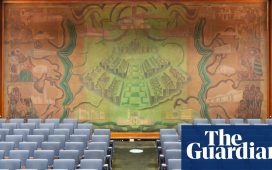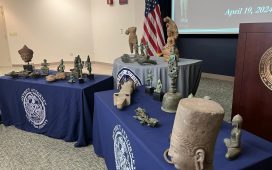In the evening light, Maribel Malagon stepped outside into a rain storm.
It was late October and Malagon, 53, had worked all day picking crab off the eastern shore of Maryland. That night, she and a handful of other seasonal workers walked to a neighbor’s house for an evening of prayer. On the way, Malagon clutched a pendant of St Judas, the patron saint of lost causes, that hung around her neck; she hoped he would hear her prayers for more work.
About an hour later, when the women were ready to call it a night, the coastal waters had risen so high that the road leading back to their house was completely submerged.
“We didn’t know which way to go. We were afraid that we would fall into the ditches,” Malagon said in Spanish, thinking back on that night two years ago. To make it back home, the women waded through knee-high murky waters. “The island is changing every year.”
For more than 20 years, Malagon has been coming to work in crab processing plants on Hoopers Island, one of the many island communities in the Chesapeake Bay.
Hoopers Island, a chain of small islands linked by causeways, has been the center of the state’s seafood industry since the early 1900s. Due to its low-lying nature, the region has faced erosion and destructive storms over the years.
But rising sea levels are increasing the frequency of flooding, creating uncertainty for the village’s watermen and their families, who have long depended on the seafood industry for their livelihoods. The situation is especially worrying for female migrants such as Malagon, who have limited job prospects back home in Mexico and wonder how long they will be able to work on the island.
Twenty-four years ago, when Malagon first arrived on the island, her output was prolific. With the precision of a machine and a sharp tiny knife in hand, she would break off the claws, crack open the shells, remove the legs, and scrape out the white meat into containers in seconds. She estimates picking between 40 and 48lbs of crab meat in her eight-hour shift.
Now, she says 10 hours could go by, and she’ll only have picked 30lbs. She suspects the crab population has decreased in number and size over the years.
“The crab was huge in my first years here. Our hands would hurt from how big they were. We produced a lot of pounds, but unfortunately, we were paid $2 a pound back then,” said Malagon, who works for one of the five crab houses that remain.
Aubrey Vincent, the owner of Lindy’s Seafood, a processing plant on the island, said wages have significantly increased for her employees. They make about $16 an hour, compared to four or five years ago when they made $7.52 an hour, she said.
Some employers pay workers per pound, so the more abundant the catch and meatier the crabs, the more money the women can send home.
“For the past five or six years at least, the work is not 100% consistent every season, and it seems to sometimes vary across workplaces,” said Julia Coburn, director of projects and special initiatives at Centro De Los Derechos del Migrante (CDM), an advocacy group that supports workers in the region.
“The workers are coming with certain expectations about what they can pick in a season and how much pay they can take home, and that’s changing. It’s having a widespread impact on their families beyond their immediate circumstances.”
Vincent said the unpredictable nature of the work has to do with more with shifting environmental conditions and weather than any fluctuations in crab availability. She described an industry at odds with numerous economic conditions.
“You’ve got a certain amount of costs [of doing business] that have gone up, just like everybody else’s expenses,” she said.
Crab populations fluctuate yearly and have always been difficult to predict. But recent years have raised concerns among the state’s seafood houses, which have relied on the temporary worker program since the 1980s, to stay open.
Each winter, when crabs are in semi-hibernation, Maryland and Virginia conduct a survey to estimate the number of blue crabs in the Chesapeake Bay and its tributaries. In the mid-1990s to the late 2000s, there was a dramatic decline in the blue crab population. Biologists, as well as the federal and state governments, believed that the problem was due to overfishing and poor water quality, causing a decline in habitat and food, which ultimately led to restrictions on the number of crabs caught for commercial sale in 2008.
The 2022 survey estimated 227m crabs, the lowest ever recorded in the survey’s 33-year history. This led to new limits on the number of male and female crabs watermen could harvest. In 2023, the population bounced back to 323m, a 40% increase; while these figures are encouraging, scientists urge continued vigilance based on low numbers of juvenile crabs.
Today, researchers believe overfishing is less likely to be the sole contributing factor, and instead argue that factors related to the climate crisis could be affecting blue crab reproduction and survival.
“We’re certainly seeing evidence in the data that reproductive success is declining,” said Tom Miller, a professor of fisheries science at the University of Maryland Center for Environmental Sciences who studies blue crab populations.
The climate crisis could affect the blue crab population in other ways. With shorter winters, crabs could face a longer fishing period, meaning more of them would be caught, said Miller. However, he added that the impact is unclear and an active area of research. Ocean acidification may also contribute to the shells of blue crabs becoming less strong, making them more susceptible to predators.
Conservationists also believe pollution and the recent decline in the Bay’s underwater grasses is likely contributing to low blue crab numbers. Another factor could be the presence of the invasive blue catfish in the Chesapeake Bay.
“They’re going to be doubly impacted by not only shorter winters, but the shells will become less strong than they once were. There’s a lot changing in the world for crabs,” said Miller.
The 2024 blue crab winter dredge survey results will be released in May.
Despite the unpredictable and temporary nature of the work, many women in central Mexico vie for these positions when recruiters come to towns, hoping to score work authorization.
“What we make here in a day would take us a week to make back home,” said Elia Ramirez Rangel, a crab-picker from Hidalgo.
For women in particular, there is a dearth of job opportunities in their communities in Mexico and abroad in the US. For some, crab-picking is their best chance of finding sustainable work, said Coburn.
“There is no source of work back home,” a laborer working on the island for 14 years said in Spanish. She spoke to the Guardian on condition of anonymity for fear of employer retaliation.
In 1996, she left Mexico to make a living picking crabs in the Carolinas. She described having to make the arduous decision to leave her two children, aged nine and 11, in the care of her sister and family friends. Over the years, with her earnings and faith in God, she said she was able to afford a house and basic necessities like food and clothing for her children, who are now grown.
“It’s been very difficult for me to be far away from them. Even though they’re grown up, I still feel like there’s a void,” she said in Spanish. “When I left them, I didn’t see their achievements, for example, in school. I missed their birthdays.”
In 2021, women made up just 12% of H-2B visa recipients to the US. On Hoopers Island, these women often describe coming to the US for work out of necessity. For nine months out of the year, they report leaving their families and children behind for a steady, albeit seasonal, paycheck.
Some workers, like Malagon, come to Hoopers Island year after year to work in the local seafood industry, so long as their seasonal work visas are granted. Her father spent decades picking under the hot sun in California’s farmlands as a bracero. At the age of 22, she said poverty and desperation led her to follow in her father’s footsteps; later, she switched to picking crabs, a job her father described to her more suited for women.
Over the course of the 20th century, crab-picking in the US became gendered and racialized work. Research shows picking crab meat was work delegated to women based on beliefs that their hands are typically smaller and more nimble. Some scholars argue hiring immigrant workers was a way to pay women less for the work.
Crab houses say they have turned to workers from Mexico in recent decades because of a local labor shortage. In order to obtain visas, they need to prove local workers are not able to fulfill those jobs. Before the 1980s it was low-paid work largely carried out by Black women.
The journey from central Mexico to Maryland involves an arduous three-day journey by bus. For Malagon, the biggest sacrifice has been the time spent away from her sisters, mother, and son.
“Leaving was horrible,” said Malagon in Spanish, who sends money home to her aging father. Seasons spent laboring abroad have allowed her to transform her family’s once-dilapidated property in the countryside of Guanajuato into a comfortable living space.
“The grace of God has given me license to build everything I wanted. I have comforts that I didn’t have before,” Malagon said. “We used to sleep on the floor when we were kids, but now, thank God, we have beds. We’ve got a fridge, we’ve got a TV.”
With the rising cost of living and less predictable hours, some women report earning less than they once did.
Previously, working 10-hour days six days a week could earn them $280 a week, but now, with workers reporting dwindling crab harvests, they sometimes only work three to four days a week and for shorter periods of time. Vincent said women have the opportunity to earn above their hourly rate if they are more productive.
Other crab-house owners acknowledge that workers may take home less pay depending on the harvest. Jay Newcomb, the former owner of Old Salty’s, a popular crab house and restaurant on the upper island, said his employees make $5 a pound or $17.50 an hour.
“That can fluctuate due to the quality of crabs, males versus females, the size of the crabs. Some days it may be better but we have to pay whatever is the highest,” said Newcomb, who downsized his operations in 2021 and sold Old Salty’s to open a smaller restaurant on nearby Taylors Island.
The federal average rate is currently $16.42 an hour.
To fill their idle hours, many of the women make phone calls home, watch TV together, or look for ways to earn extra income. Currently, workers in Maryland’s seafood industry are exempt from minimum wage and overtime protections under state law.
Without public transportation, they often pay or rely on favors from acquaintances to drive them 40 minutes to the nearest city of Cambridge for errands.
Over time the repetitive hand motion of picking crab can result in arthritis, back pain, allergies to crab meat, and cuts to their hands from working quickly with the knives used to cut the shells open, acccording to CDM. Vincent acknowledged that crab picking, like other production jobs, can be physically demanding.
The advocacy group also said that women are disincentivized from reporting work-related issues or take sick days because their immigration status is tied to their employer, making them susceptible to labor abuses. Vincent said she provides an anonymous tip line where employees can report issues.
Despite the challenges, the women emphasize that they are grateful for the opportunity to work and note that there have been some improvements over time.
Today migrant workers have successfully gained more labor protections in part due to laborer testimony and a coalition of groups such as CDM, which have fought for policies that improve working conditions.
Some women have begun organizing a Comite de Defensa, where they discuss ongoing issues such as Covid-19 vaccine information, accessing healthcare in this remote region, and how to report work-related injuries. Part of that work also involves disseminating information about their rights with other women on the island and their families, many of whom are also contractors.
The view from the cabin where Malagon rents from her employer overlooks the Honga River estuary and distant pine forests. A tree directly outside the house that once provided shade and a place to hang dry clothes was swept away in a storm recently, leaving only a small stump behind.
This three-and-a-half-mile stretch of land known as Hoopersville is the middle island of the three that make up Hoopers, dividing the Honga River from the Chesapeake Bay.
Surrounded by a lush ecosystem of marshland, wildlife and tall seagrass, the women are also geographically and socially isolated.
Nestled in Dorchester county, a tight-knit community with predominantly conservative values, the women say they turn to their faith in God and seek solace in each other’s company while away from home.
The narrow bridge connecting the middle to the upper island routinely floods in high tide, leaving the women trapped. Lower Hoopers Island, formerly Applegarth, became uninhabitable due to erosion, and a hurricane washed away the bridge in 1933.
Malagon vividly remembers the first time she saw the bay’s waters encroaching on the doorstep of the house in 2006. “When I looked outside, I was terrified,” she said. “We had never seen the tide rise that high. Now we see it as more normal.”
Flooding has become routine in recent years, threatening the daily lives and futures of locals and women alike.
The Chesapeake Bay has risen by about one foot during the past century, which is nearly double the global average. By 2050, sea levels are projected to rise by as much as two feet. Climate models predict that over half of Dorchester county, the third-largest county in Maryland by land area, could be underwater by the end of the century.
Vincent said she has an emergency management plan for a major flooding event during work hours, where she would evacuate her employees, but says there’s only so much she’s responsible for as an employer.
CDM argues there is a pressing need for climate adaptation measures from both governments and employers to safeguard seasonal workers’ well-being in the long run.
“With roads washing out, the communication lines go down – it just increases all these layers of vulnerability,” said Coburn.
“The truth is it’s very beautiful living here – except when the tide rises,” said the laborer who has worked on the island for 14 years. During a recent grocery trip to Walmart, 40 minutes away, she said her housemates were unable to return to the island because the bridge was closed due to flooding.
Language barriers can make it difficult for women to stay informed and they often rely on word of mouth from other workers about the bridge flooding.
With every passing season, the grueling nature of the job and looming precarity can take a toll emotionally and physically – some of the women question whether it’s worth coming back.
“As long as we’re here, we’re going to make the most of it,” said Clara Ramirez, a worker at GW Hall & Son, one of the crab processing plants on the island. (GW Hall & Son did not respond to requests for comment.)
Some owners share a common sentiment.
“We just do the best we can with what we’ve got, and ultimately, everybody’s goal is the same: to try and make a living,” said Vincent.
Back at the house, a group of women started to arrive for the new crab season that started on 1 April.
This year more visas have been made available, and Vincent scored 80 visas for her employees through the lottery system. Speaking via WhatsApp from Mexico in early April, Malagon said she was getting ready to make the trip to Maryland via bus. If all goes well, she and the other workers from Lindy’s will arrive by 15 April.
Newcomb, the former owner of Old Salty’s, said he won 23 employee visas this season, up from the roughly 18 or 20 he’s gotten in previous years.
AE Phillips & Son, another crab house on the island, was unable to obtain visas and will not be operating this season, a major setback for the company and its employees.
Malagon says she has put her faith in God for a bountiful season, with hopes of returning every year to have enough money to retire. Still, she worries for the future of the industry and the region itself.
“If God allows it, my goal is to work for 10 more years. But if there’s no crab, what will we do then?”








